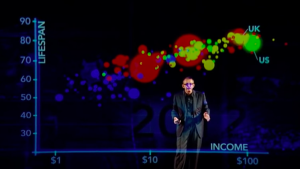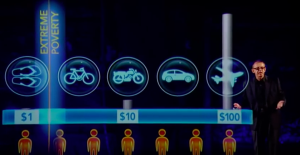 Don’t Panic – The Truth About Population
Don’t Panic – The Truth About Population
This documentary with Hans Rosling is fascinating and shows how it’s quite easy to get the wrong idea about world population growth without all the relevant facts. I’m grateful to my friend, Vetle, who suggested I take a look at this documentary. I’m glad he did. I’ve learnt a lot about population and most of what Hans says makes intuitive sense.
The most interesting parts for me were that we are at peak-child already, we will plateau at 11 billion people, but that’s not scary, we have a chance to end extreme poverty and the richest people must adjust their energy usage to help avoid climate change.
Here’s the documentary itself and, below that, you can find all my notes from it.
My Notes – Don’t Panic – The Truth About Population
- Should we be worried and scared about population growth?
- 7 billion people live on our planet now
- population growth was very small up to the year 1800 and has been almost exponential since
- most have the world’s population has been added in the last 60 years!
- for example, Bangladesh has tripled from 50 to 150 million in the last 60 years
- but families in Bangladesh are now deciding to have just two children
- in the last 40 years Bangladesh has gone from 7 children per woman to just over 2, while life expectancy has risen from in the 40’s to over 70
- this is a global trend – all developing countries are heading this way – world average children per woman is down from over 5 to 2.5
- this is a amazing change for the last 50 years
- this has mainly been fuelled by a dramatic rise is child survival rates
- in 1800, the average world family had 6 children but 4 died before reaching adulthood
- in 1963, the average world family had 5 children but 1 died before reaching adulthood
- in 2000, the average world family had 2 children and both survived
- by 2100, we expect to reach 11 billion people but with a dramatic slowing of growth at the same time
- by 2000, the world reached 2 billion children under 15 years of age
- this is expected to stay flat and be still 2 billion in year 2100
- it is said that the world reached “peak child” around the year 2000
- he has a very good visual way of showing how we will go from 7 billion people now to 11 billion, without any increase in the number of children being born – this makes good sense
- right now we have 1 billion in the Americas, 1 billion in Europe, 1 billion in Africa and 4 billion in Asia
- by 2100, we will have 1 billion in the Americas, 1 billion in Europe, 4 billion in Africa and 5 billion in Asia, and this will be a stable state
- there’s a beautiful story about the importance of a bicycle to the rural poor in Africa
- of the seven billion people in the world today, the richest billion earns $100 per day
- the middle billion earns just $10 per day
- the poorest billion earns just $1 per day
- the line of extreme poverty is just a little about $1 per day
- he shows how the $100 per day people look back on everyone else and think they are all poor, but the $1 per day people know full well how much better their lives would be if they could move up to the $10 per day range
- the family they were reviewing in Africa moved up to being able to buy a bicycle – it took all morning to walk to the market, but less than an hour to ride home – this will speed their prosperity along
- now the father of the family has aspirations to save and buy a motorbike
- Hans has a great graph with an x-axis of “income” and a y-axis of “lifespan”
- in 1800, all countries were low in income and lifespan ($1-10 per day and about 30 years)
- during the 1800’s the developing countries moved higher in wealth, but not really in lifespan
- around 1900, there began an increase in lifespan
- during the 1900’s the US and the UK led the way upwards and to the right to reach the $100 per day point and a lifespan around 80
- all other countries have followed and are following the same trend, with Asia and Africa bringing up the rear
- today, the African countries are in the $1-10 per day range with a lifespan around 60
- he shows how in 1963, a large percentage of people in Asia and Africa were in extreme poverty
- today, a much smaller proportion of the world’s population is in extreme poverty – Asia has moved well out of it and Africa is moving in the right direction quickly (however, there’s still more than 1 billion people in extreme poverty)
- I don’t like his vision of Africa turning towards conventional western farming practices – hopefully we won’t make those mistakes again (artificial pesticides and fertilisers, etc.)
- the part of the world in extreme poverty tends to get stuck – it needs help
- problem – more wealth overall means more usage of machines and more energy – threatening climate change
- he says 80% of the energy the world is using is still fossil fuels
- the richest billion people burn half of the world’s fossil fuel burnt each year
- the second richest billion use a quarter of the world’s fossil fuel burnt each year
- the third richest billion use an eight of the world’s fossil fuel burnt each year
- the poorest four billion people use hardly any fossil fuels by comparison (only 15% all told really)
- he says “the richest people, burning the most fossil fuels, look down on the others and say ‘oh, you cannot live like us, you will destroy the planet!!’ ” – I like that view
- “everyone uses a washing machine, even the hard-core of the environmental movement”
- we have the chance, for the first time in history, to end extreme poverty for good
- the problems of population growth have been solved by reaching peak-child
- the problems of climate change require the richest people to reset their energy use in such a way that it can be shared with 10-11 billion people (see Use 10 Percent Less)
- “the world is much better than many of you think”
Related Links – Don’t Panic – The Truth About Population
- Hans Rosling’s gapminder.org


Peter,
Thanks for the video. It was very interesting to see this information presented with some really innovative visualizations. We found Hans’ optimism and candor very refreshing, compared to the usual prophet-of-doom headline grabbing style of presentation you see elsewhere.
In particular, I liked the way he explained the concept of integration to people without resorting to graphs!